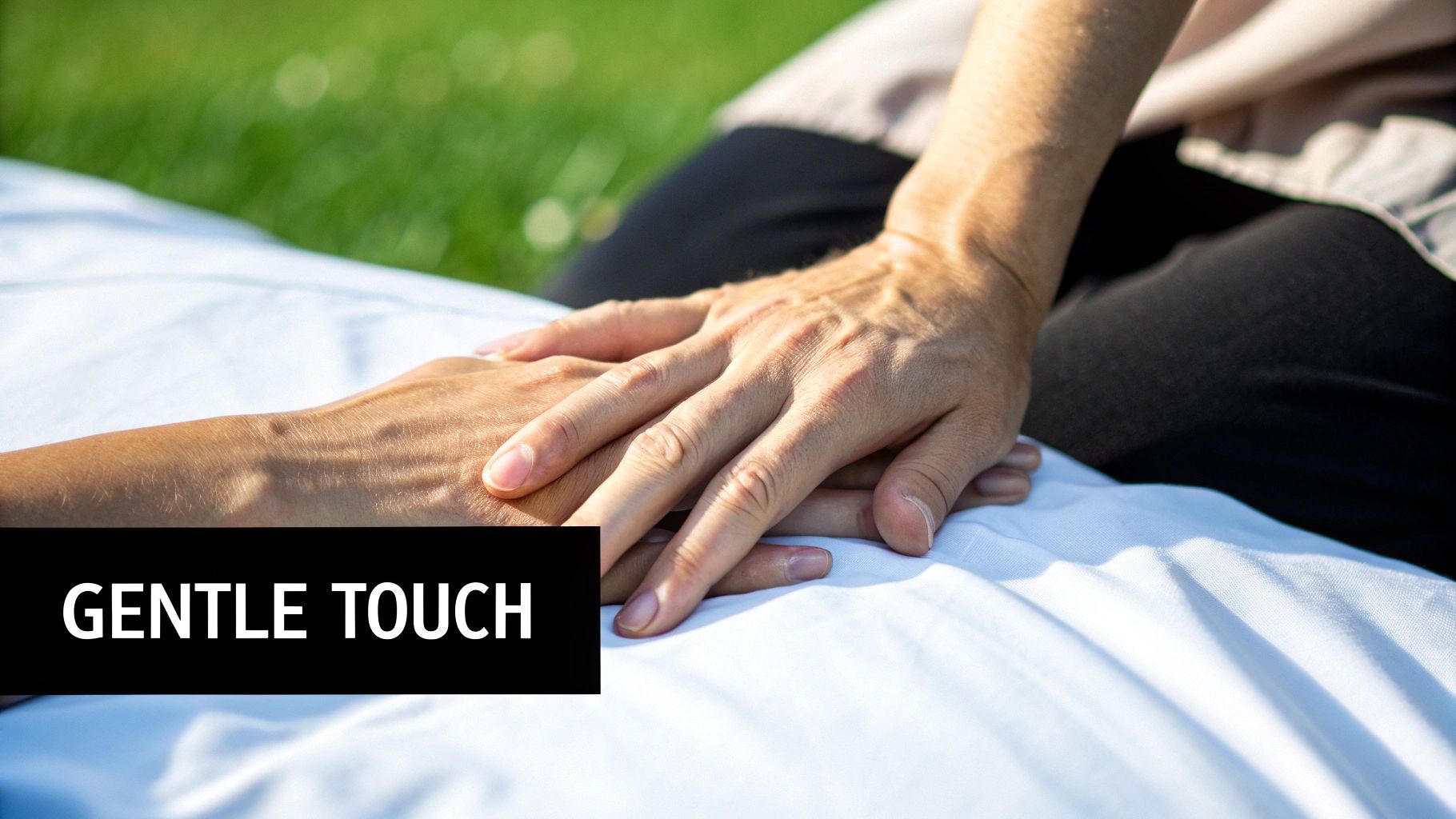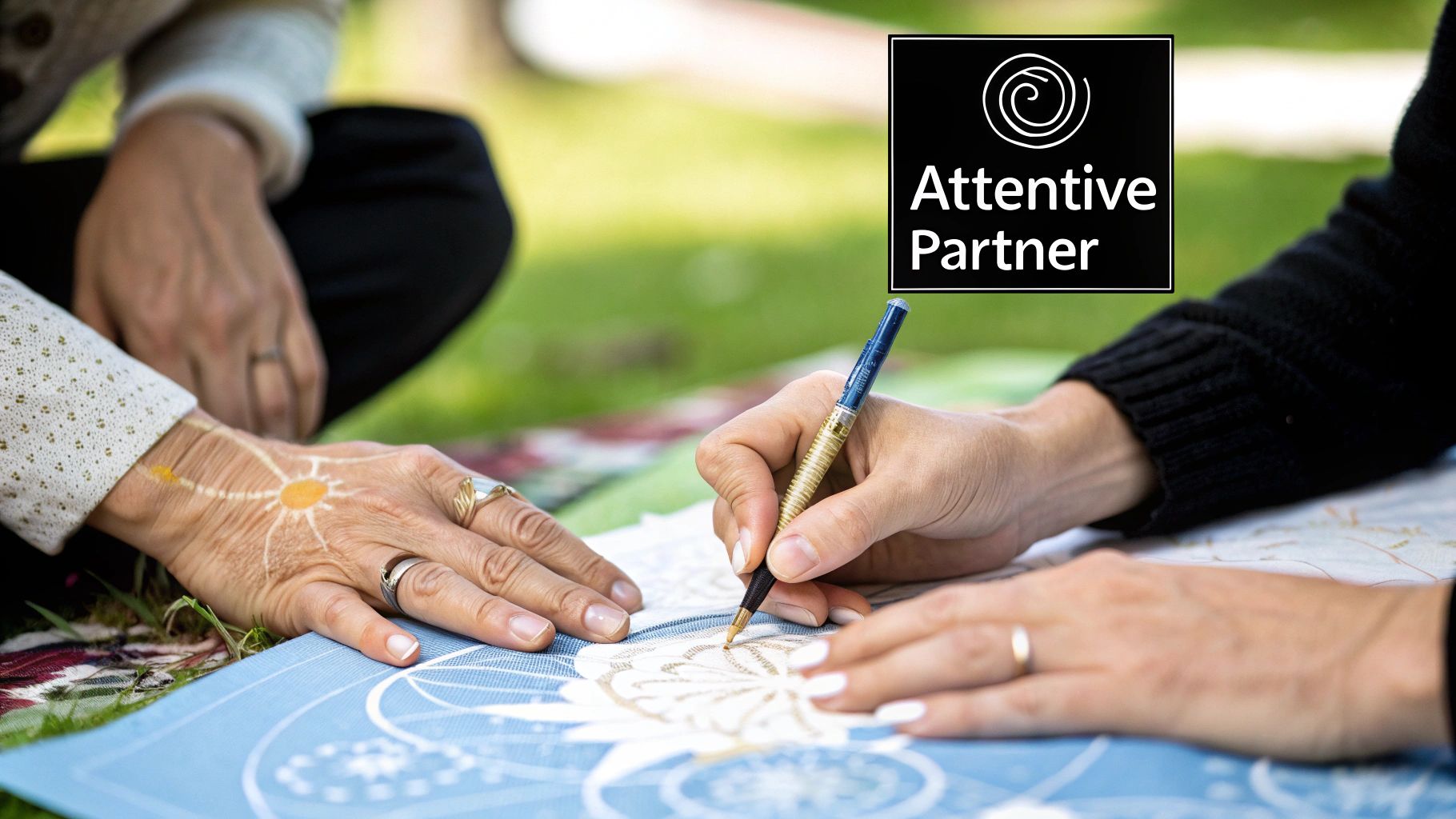Unlocking the Secrets of Female Arousal
Want to know what makes a woman wet? This listicle explores the eight key factors influencing female arousal, empowering you to create more satisfying intimate experiences. Understanding what truly turns a woman on goes beyond the physical. We’ll cover everything from the importance of emotional connection and mental arousal to the roles of physical foreplay, hormones, communication, and environmental factors. Plus, we’ll dive into the significance of your skill and attention as a partner, as well as her own self-knowledge and comfort. Mastering these elements will deepen your connection and unlock greater pleasure for both of you.
1. Emotional Connection
When exploring what makes a woman wet, emotional connection often tops the list. It’s a cornerstone of female arousal, laying the groundwork for physical intimacy. For many women, feeling safe, understood, and valued by their partner is a prerequisite for physical arousal. This isn’t just about romance; it’s about a deep, psychological connection that fosters trust and vulnerability. This emotional bonding activates the limbic system, the part of the brain responsible for emotional responses, which in turn can trigger physiological responses like arousal. This explains why a woman might feel more aroused after a heart-to-heart conversation than after simply receiving compliments on her appearance.

This emotional connection involves several key features: building trust over time, sharing vulnerabilities with each other, engaging in deep and meaningful communication, and creating a space of emotional safety. These elements create a positive feedback loop. Trust allows for vulnerability, vulnerability strengthens communication, and open communication builds a sense of safety. This, in turn, fosters a deeper emotional connection, making physical intimacy more likely and more enjoyable.
For men seeking to understand what makes a woman wet, grasping the importance of emotional connection is crucial. It’s the difference between seeing intimacy as a purely physical act and understanding it as an expression of a deeper bond. For example, couples who prioritize active listening and empathetic communication often report higher levels of arousal and sexual satisfaction. Similarly, partners who engage in meaningful conversations before intimacy often experience a deeper connection and heightened arousal.
Pros:
- Creates sustainable arousal patterns: Unlike fleeting physical stimulation, emotional connection builds a foundation for long-term intimacy and arousal.
- Enhances overall relationship satisfaction: A strong emotional connection strengthens the entire relationship, leading to greater happiness and fulfillment both inside and outside the bedroom.
- Leads to more fulfilling sexual experiences: When a woman feels emotionally connected, sex becomes more than just a physical act; it becomes an expression of love, trust, and vulnerability, leading to more intense and satisfying experiences.
Cons:
- Takes time to develop: Building true emotional intimacy requires time, patience, and consistent effort. It’s not a quick fix.
- Requires ongoing maintenance: Like any important aspect of a relationship, emotional connection needs ongoing nurturing and attention to stay strong.
Tips for Building Emotional Connection:
- Practice active listening without interruption: Truly listen to your partner when she’s talking. Focus on understanding her perspective rather than formulating your response.
- Share vulnerable thoughts and feelings: Opening up to your partner about your own insecurities and fears creates a safe space for her to do the same.
- Express appreciation regularly: Let your partner know how much you value her, both for who she is and what she does.
- Create rituals for emotional check-ins: Set aside dedicated time to connect with your partner emotionally, whether it’s a weekly date night or a daily check-in conversation.
Emotional connection deserves its top spot on the list of what makes a woman wet because it addresses the fundamental need for intimacy and security that underpins female arousal. It transforms intimacy from a purely physical experience into a profound expression of love and connection, leading to more fulfilling and satisfying experiences for both partners.
2. Physical Foreplay
One of the most crucial elements in understanding what makes a woman wet is physical foreplay. This involves stimulating a woman’s body before intercourse through touching, kissing, caressing, and massage. These actions increase blood flow to the genitals, activating nerve endings and triggering the release of natural lubricants, which is essential for comfortable and pleasurable sex. It’s important to understand that this process generally takes longer for women than men. Research suggests women often need 20+ minutes of stimulation to reach full arousal. This underscores the importance of patience and a focus on the journey, not just the destination.

Physical foreplay deserves a prominent place on this list because it directly addresses the physiological mechanisms of female arousal. It’s not just about getting her in the mood; it’s about creating the physical conditions necessary for her to enjoy sex. The key features of effective physical foreplay include progressive touch patterns, stimulating multiple erogenous zones, and varying pressure and techniques. This means starting with gentle touches in non-sensitive areas and gradually moving towards more intimate areas like the clitoris, breasts, and inner thighs. Experimenting with different types of touch, from light strokes to firmer pressure, can also heighten the experience.
Examples of Successful Implementation:
- Progressive Massage: Begin with a relaxing back massage, gradually moving towards the buttocks and then the inner thighs. This slow progression allows her body to warm up and become receptive to more intimate touch.
- Escalating Kisses: Start with soft, gentle kisses on the face and neck, gradually increasing intensity and moving towards the lips and then other erogenous zones.
Actionable Tips:
- Focus on the Journey: Don’t rush the process. Foreplay should be enjoyable in itself, not just a means to an end.
- Pay Attention to Non-Verbal Feedback: Watch her body language. Is she leaning into your touch or pulling away? Adjust your technique based on her responses.
- Vary Pressure, Speed, and Location: Don’t be afraid to experiment and discover what she enjoys.
- Communicate: Ask her what she likes and what feels good. Open communication is key to satisfying foreplay.
Pros:
- Increases Natural Lubrication: This makes intercourse more comfortable and pleasurable for both partners.
- Enhances Pleasure During Intercourse: Arousal built through foreplay intensifies the overall sexual experience.
- Reduces Discomfort: Adequate lubrication minimizes friction and discomfort during sex.
Cons:
- Effectiveness Varies Based on Menstrual Cycle: Hormonal fluctuations can influence a woman’s responsiveness to physical stimulation.
- May Require Adaptation as Relationship Evolves: Preferences and sensitivities can change over time, so ongoing communication and adaptation are essential.
By understanding the importance of physical foreplay and incorporating these tips, you can significantly enhance your partner’s pleasure and create a more fulfilling sexual experience for both of you. This approach is particularly valuable for men in relationships who want to deepen intimacy and understand their partner’s body better. Remember, taking the time to connect physically and emotionally through foreplay is a key ingredient in understanding what makes a woman wet.
3. Mental Arousal
When exploring what makes a woman wet, understanding the profound impact of mental arousal is crucial. Often referred to as the most significant sexual organ, the brain plays a pivotal role in female arousal. This involves engaging in fantasy, building anticipation, and eliminating mental blocks like stress and distractions. It’s not just about physical stimulation; it’s about creating a mental space conducive to desire and pleasure. Neuroscience research highlights that female arousal activates different brain regions compared to male arousal, with greater emphasis on areas associated with emotional processing and context evaluation. This underscores the importance of emotional connection and a sense of safety for many women.

Mental arousal thrives on several key features: active engagement in fantasy, the delicious build-up of anticipation, the reduction of stress, and cultivating mindfulness during intimacy. Imagine the power of using erotica, crafting playful and suggestive messages throughout the day, or simply taking the time to truly connect with your partner on an emotional level. These are all powerful tools for stoking the fires of mental arousal.
The benefits of prioritizing mental arousal are numerous. It can be developed independently, enhancing the physical response to stimulation and providing a solid foundation for arousal. This means that even without physical touch, a woman can begin to experience the initial stages of arousal, making the transition to physical intimacy smoother and more enjoyable.
However, mental arousal also has its challenges. External stressors can disrupt the delicate balance, and managing intrusive thoughts might require active effort. For instance, a stressful day at work or anxieties about performance can significantly impact a woman’s ability to connect with her desire.
Here are some practical tips to cultivate mental arousal and enhance sexual experiences:
- Practice mindfulness techniques: Staying present in the moment can help quiet the mental chatter and heighten sensations.
- Communicate about fantasies: Sharing fantasies with a partner can create a deeper sense of intimacy and understanding, leading to more fulfilling sexual experiences.
- Create a relaxing environment: Minimize distractions like phones or bright lights to foster a sense of intimacy and focus.
- Use guided sensate focus exercises: These exercises can help both partners tune into their senses and appreciate the subtleties of touch and connection. Exploring and enhancing various aspects of well-being, including sexual experiences, can sometimes benefit from additional support. In this context, resources like hypnosis for sexual pleasure from Hypnothera.ai may offer valuable tools and techniques.
Mental arousal deserves its place on this list because it is fundamental to what makes a woman wet. It’s the spark that ignites desire, the engine that drives pleasure, and the key to unlocking deeper, more fulfilling sexual experiences. By understanding and prioritizing mental arousal, men can significantly enhance their partner’s pleasure and build a stronger, more intimate connection. The work of experts like Dr. Emily Nagoski, author of ‘Come As You Are’, and Dr. Lori Brotto, a renowned mindfulness researcher, further emphasizes the crucial role of the mind in female sexual well-being.
4. Hormonal Influences
Understanding a woman’s hormonal fluctuations is key to understanding what makes a woman wet. A woman’s hormonal state plays a significant role in her sexual arousal and the natural lubrication that accompanies it. The primary hormone at play is estrogen, which directly impacts the health and lubrication capacity of the vaginal tissues. These estrogen levels are not static; they ebb and flow throughout the menstrual cycle, influencing a woman’s responsiveness and overall sexual experience. This dynamic interplay of hormones is a crucial factor in what makes a woman wet and deserves a prominent place on this list.

One of the most noticeable examples of this hormonal influence is the increased arousal and lubrication many women experience during ovulation, roughly midway through their menstrual cycle. This is when estrogen levels are at their peak. Conversely, times when estrogen levels are lower, such as during menopause or postpartum periods, can often lead to decreased natural lubrication and potentially discomfort during intimacy. Furthermore, certain medications, including some types of birth control, can also impact hormone levels and subsequently affect vaginal wetness.
The cyclical nature of these hormonal shifts offers both benefits and challenges. By tracking her cycle, a woman can identify her optimal times for intimacy and anticipate potential fluctuations in arousal and lubrication. This knowledge can empower both partners to plan for more satisfying sexual experiences. Moreover, decreased lubrication due to hormonal changes can often be addressed with various treatments, including topical lubricants or hormone replacement therapy. However, these hormonal influences are largely outside an individual’s direct control and can be unpredictable. This is where open communication and understanding between partners become essential.
Features of Hormonal Influence on Wetness:
- Cyclical Changes: Expect variations in lubrication throughout the month.
- Age-Related Variations: Menopause and postpartum periods can significantly impact lubrication.
- Medication Impacts: Certain medications, especially hormonal birth control, can affect estrogen levels.
Pros:
- Trackable for Optimal Timing: Understanding cyclical changes can help predict peak arousal times.
- Treatable: Decreased lubrication can be addressed through various methods.
Cons:
- Outside Individual Control: Hormonal fluctuations are a natural process and not easily manipulated.
- Medication Side Effects: Some medications can negatively impact natural lubrication.
Tips for Men:
- Encourage Cycle Tracking: Support your partner in tracking her cycle to better understand her body’s natural rhythms. This shared knowledge can enhance intimacy.
- Be Prepared with Lubricant: Keep lubricant on hand for times when natural lubrication might be lower. This demonstrates consideration and can greatly improve the experience for both of you.
- Open Communication: Talk openly with your partner about any concerns or changes she experiences. Understanding and empathy go a long way in fostering a healthy and fulfilling sexual relationship.
- Consult Healthcare Providers (Together): Encourage your partner to consult a healthcare provider about any concerns related to hormonal changes or medication side effects. You can offer to attend appointments with her to show your support and learn more together.
The insights of experts like Dr. Prudence Hall, a hormone specialist, and Dr. Christiane Northrup, a renowned women’s health expert, have popularized the understanding of hormonal influences on female sexuality. By recognizing and understanding these influences, men can gain valuable insights into what makes a woman wet and contribute to a more fulfilling and pleasurable experience for both partners.
5. Communication and Consent: The Key to Unlocking Her Pleasure
When exploring what makes a woman wet, many men focus solely on the physical. However, one of the most powerful aphrodisiacs for women is psychological: communication and consent. Open and honest communication about desires, boundaries, and preferences lays the foundation for the psychological safety and trust essential for arousal. It allows a woman to relax, let go, and fully embrace the experience, making it far more likely she’ll become physically aroused and enjoy satisfying sex. This is why communication and consent deserve a prominent place on this list.
Research consistently shows that women who feel comfortable communicating their sexual needs experience greater arousal and satisfaction. This involves both verbal and non-verbal communication that establishes ongoing enthusiastic consent. It’s not a one-time “yes,” but a continuous dialogue throughout the intimate experience.
How it Works:
Communication creates a positive feedback loop. When a woman feels safe expressing her desires, she’s more likely to become aroused. Her partner, now aware of what works, can tailor their approach, further increasing her pleasure. This shared understanding builds trust and intimacy, leading to even better sex in the future.
Features of Effective Communication and Consent:
- Clear Boundary Setting: Openly discussing what feels good and what doesn’t, both physically and emotionally.
- Preference Sharing: Communicating desires and fantasies without fear of judgment.
- Feedback Loops: Giving and receiving real-time responses during intimacy about what is pleasurable.
- Consent Practices: Regularly checking in with each other to ensure both partners are comfortable and enthusiastically participating.
Pros:
- Increases Partner Awareness of Effective Techniques: Knowing what turns her on allows you to focus on what works.
- Reduces Anxiety about Unexpressed Needs: She can relax and enjoy the experience without worrying about unspoken desires or discomfort.
- Builds Trust and Intimacy: Open communication strengthens the emotional connection between partners.
Cons:
- Can Feel Vulnerable or Uncomfortable Initially: Talking about sex can be difficult at first, requiring vulnerability and courage.
- Requires Partner Receptiveness: Open communication only works if both partners are willing to listen and adapt.
Examples:
- Partners who establish regular check-ins during intimacy, asking questions like, “Does this feel good?” or “Do you want to try something different?”
- Couples who develop personalized ‘yes/no/maybe’ lists, outlining sexual activities they are enthusiastic about, opposed to, or open to exploring.
Actionable Tips for Men:
- Use Positive Reinforcement Rather Than Criticism: Focus on what she enjoys and encourage her to explore her desires. Instead of saying, “You never seem to enjoy this,” try, “I noticed you really seemed to like it when I…”
- Develop a Comfortable Vocabulary for Discussing Intimacy: Find words and phrases you both feel comfortable using to talk about sex.
- Practice Expressing Needs Outside the Bedroom First: Start by communicating about everyday preferences to build comfort with expressing desires.
- Create Signals for Non-Verbal Communication: Develop subtle cues for indicating pleasure or discomfort during intimacy.
Popularized By:
- Dr. Betty Dodson, sex educator
- Dr. Emily Morse, Sex with Emily podcast
By prioritizing communication and consent, you’re not just increasing the likelihood of her getting wet; you’re building a stronger, more fulfilling sexual connection based on trust and mutual respect. This approach benefits both partners and creates a more enjoyable and satisfying intimate experience.
6. Environmental Factors: Setting the Stage for Arousal
When exploring what makes a woman wet, it’s crucial to understand the profound influence of environmental factors. A woman’s physical surroundings play a significant role in her ability to relax and become aroused. This encompasses everything from ensuring privacy and comfort to optimizing temperature, aesthetics, and sensory stimulation. Think of it like setting the stage for a captivating performance – the right environment can make all the difference. Environmental psychology research backs this up, demonstrating that a woman’s feeling of security and comfort in her surroundings allows her autonomic nervous system to relax, a prerequisite for arousal to occur. This is why this factor deserves a prominent place on this list.
How it Works:
The connection between environment and arousal is rooted in the brain’s response to external stimuli. When a woman feels safe and comfortable, her body is more likely to produce lubrication, a key indicator of arousal. Conversely, a distracting, uncomfortable, or unsafe environment can inhibit the physiological processes that lead to getting wet. Features like soft lighting, pleasant scents, and relaxing music can create a sensory experience that promotes relaxation and enhances arousal. Essentially, by appealing to her senses, you’re creating a conducive atmosphere for intimacy.
Features and Benefits:
- Privacy Considerations: A sense of privacy is paramount. Knowing she won’t be interrupted or overheard allows a woman to fully relax and let go.
- Sensory Elements: Lighting, scent, and sound play crucial roles. Dim lighting creates a sense of intimacy, while aromatherapy with mood-enhancing scents like lavender or vanilla can heighten arousal. Soft music or ambient sounds can also contribute to a relaxing atmosphere.
- Temperature Control: Being too hot or too cold can be a major distraction. Ensuring a comfortable temperature is key.
- Aesthetic Appeals: A visually appealing environment can enhance the overall experience. This could involve a clean and tidy space, attractive décor, or even fresh flowers.
Pros:
- Relatively easy to modify: Most environmental factors are relatively simple to adjust and control.
- Can quickly enhance existing arousal: Small changes like dimming the lights or putting on music can have an immediate impact.
- Creates sensory associations: Positive experiences in a specific environment can create positive associations that enhance arousal in the future.
Cons:
- May not be fully controllable: Unexpected interruptions or external noise can disrupt the mood.
- Preferences can vary widely: What one woman finds relaxing, another might find distracting. Communication is key to understanding her preferences.
Examples:
- Creating a romantic ambiance with soft lighting, candles, and relaxing music.
- Using aromatherapy with scents like vanilla, lavender, or ylang-ylang, known to enhance mood and libido.
- Ensuring the bedroom is clean, tidy, and at a comfortable temperature.
Actionable Tips for Men:
- Remove potential distractions: Turn off phones, televisions, and other devices that could interrupt the moment.
- Experiment with different environmental elements: Try different lighting, music, and scents to find what works best for both of you.
- Consider all five senses: Think about how you can create a pleasurable experience that engages all her senses.
- Ensure adequate privacy and comfort: Make sure she feels safe, secure, and undisturbed.
- Communicate: Talk to your partner about her preferences. Ask her what makes her feel comfortable and relaxed.
Popularized By:
Experts like relationship therapist Esther Perel emphasize the importance of creating a conducive environment for intimacy. Even luxury hotel brands capitalize on this, designing rooms specifically for intimate experiences.
By paying attention to these environmental factors, you can significantly enhance her arousal and create a more enjoyable and fulfilling intimate experience for both of you. This understanding is crucial for any man seeking to understand what makes a woman wet and deepen his connection with his partner.
7. Partner Skill and Attention
When it comes to understanding what makes a woman wet, partner skill and attention are paramount. This isn’t just about knowing what to do, but how to do it and, crucially, how to adapt based on your partner’s unique responses. A partner’s knowledge, skill, and attentiveness to feedback plays a crucial role in female arousal and contributes significantly to a fulfilling sexual experience for both partners. This factor deserves a prominent place on this list because it directly addresses the interactive nature of sexual intimacy and emphasizes the importance of personalized pleasure.
A key aspect of this is understanding female anatomy, particularly the clitoris. With over 8,000 nerve endings, this organ is the epicenter of female pleasure for most women. Knowing its location and how it responds to different types of stimulation is crucial. Beyond the clitoris, understanding the entire vulvar area and how different touches, pressures, and rhythms can elicit varying responses is part of the learning process.
Technical skill development comes into play when putting this anatomical knowledge into practice. This isn’t about rote memorization of techniques, but rather developing a repertoire of skills and adapting them based on your partner’s feedback. This includes exploring different types of touch, varying pressure and speed, and incorporating toys if desired.
Responsiveness to feedback, both verbal and non-verbal, is vital. Pay attention to your partner’s breathing patterns, subtle body movements, and facial expressions. These cues can provide valuable insights into what’s working and what’s not. Don’t hesitate to ask for specific feedback and approach these conversations with curiosity and a genuine desire to learn.
Features of Skillful and Attentive Partnering:
- Anatomical knowledge: Understanding the clitoris, vulva, and other erogenous zones.
- Technical skill development: Mastering various techniques for stimulation and incorporating different touches, pressures, and rhythms.
- Responsiveness to feedback: Paying attention to both verbal and non-verbal cues and adapting accordingly.
- Adaptability: Being willing to adjust techniques and approaches based on individual preferences.
Pros:
- Directly addresses individual preferences: Allows for personalized pleasure and a deeper connection.
- Can evolve over time: As partners learn more about each other, their skills and responsiveness can grow, leading to even more satisfying experiences.
- Creates positive reinforcement cycles: Attentiveness and successful arousal lead to increased confidence and desire, further enhancing intimacy.
Cons:
- Requires ongoing learning and adaptation: It’s not a one-time fix but rather a continuous process of discovery.
- May involve confronting incorrect assumptions: Challenging pre-conceived notions about female pleasure can be uncomfortable but is essential for growth.
Examples of Successful Implementation:
- Partners who study female anatomy and arousal patterns from reputable sources like She Comes First by Dr. Ian Kerner or the OMGYes sexual education platform.
- Couples who openly communicate about their preferences and practice techniques learned from educational resources.
Actionable Tips for Men:
- Study reliable sources about female pleasure anatomy: Resources like OMGYes and books like She Comes First provide valuable insights.
- Pay attention to breathing patterns and subtle responses: These non-verbal cues can tell you a lot about what your partner is experiencing.
- Ask for specific feedback: Don’t be afraid to ask what feels good and what doesn’t.
- Approach with curiosity rather than assumptions: Every woman is different, so be open to learning and adapting.
By prioritizing partner skill and attention, you can significantly enhance your partner’s arousal and contribute to a more fulfilling and intimate sexual experience for both of you. This approach recognizes that understanding what makes a woman wet is a journey of shared exploration and learning, leading to deeper connection and greater pleasure.
8. Self-Knowledge and Comfort
When exploring what makes a woman wet, understanding the crucial role of self-knowledge and comfort is paramount. This factor is often overlooked, but it forms the bedrock of a woman’s ability to experience arousal and satisfaction, both solo and with a partner. Essentially, a woman who knows her own body, understands her preferences, and is comfortable exploring her sexuality is far more likely to achieve satisfying arousal. This knowledge is a key component in unlocking what makes a woman wet.
So, how does this work? It’s about fostering a deep connection with oneself. When a woman takes the time to understand what brings her pleasure, she’s not just discovering erogenous zones. She’s building a roadmap to her own arousal. This self-awareness translates into greater confidence and reduces performance anxiety, both of which can be significant inhibitors of getting wet.
Features and Benefits:
- Body Familiarity: Knowing your body intimately, including its responses to different stimuli, is foundational.
- Personal Preference Awareness: Understanding what specifically turns you on, whether it’s a certain type of touch, visual stimulation, or mental fantasy, allows you to guide yourself and your partner towards those experiences. This is essential to understanding what makes her wet.
- Comfort with Sexuality: Embracing your sexuality without shame or judgment creates a space where arousal can flourish. This comfort level allows a woman to relax, let go, and fully experience the sensations leading to lubrication.
- Self-Advocacy Skills: This empowerment enables clear communication about needs and desires, enhancing the partnered experience. A woman who can articulate her preferences is far more likely to achieve fulfilling intimacy and lubrication.
Pros:
- Creates a foundation for communicating needs: Knowing what you want allows you to express it clearly and confidently, leading to a more satisfying sexual connection.
- Reduces performance anxiety: Self-assurance eliminates the pressure to perform, promoting relaxation and natural arousal.
- Empowers personal pleasure: Understanding your body empowers you to prioritize your own pleasure, enhancing both solo and partnered experiences.
Cons:
- May be affected by cultural or religious inhibitions: Societal or personal beliefs can sometimes create barriers to self-exploration.
- Requires vulnerability and self-acceptance: This journey necessitates a degree of vulnerability and acceptance of oneself, which can be challenging for some.
Examples of Successful Implementation:
- Self-exploration practices: This could involve experimenting with different types of touch, using sex toys, or exploring erotic literature or films.
- Mindful body awareness exercises: Practices like meditation or yoga can enhance body awareness and connection.
Actionable Tips for Men Seeking to Understand Their Partner:
- Encourage open communication: Create a safe and non-judgmental space for her to share her desires and preferences. Ask questions and listen actively.
- Be patient and supportive: Self-discovery is a journey, and your partner may need time and encouragement to fully explore her sexuality.
- Focus on pleasure, not performance: Shift the focus from achieving a specific outcome (like getting wet) to exploring what feels good for both of you.
- Respect her boundaries: Pay attention to her verbal and non-verbal cues, and respect her limits at all times.
When and Why to Use This Approach:
This approach is relevant at all stages of a relationship. For new couples, it helps establish a foundation of open communication and mutual understanding. For established couples, it can reignite passion and deepen intimacy. Ultimately, fostering a woman’s self-knowledge and comfort with her sexuality is a crucial factor in her ability to get wet and experience satisfying sexual encounters. This understanding is not just beneficial for her; it enhances the shared pleasure and connection within the relationship.
This information is popularized by sexuality educators like Dr. Lexx Brown-James and organizations like The Pleasure Project (website link not provided). By prioritizing self-knowledge and comfort, you can unlock deeper levels of intimacy and pleasure for both you and your partner.
8-Factor Sexual Arousal Comparison
| Factor |  Implementation Complexity Implementation Complexity |
 Resource Requirements Resource Requirements |
 Expected Outcomes Expected Outcomes |
 Ideal Use Cases Ideal Use Cases |
 Key Advantages Key Advantages |
|---|---|---|---|---|---|
| Emotional Connection | Moderate – requires time & effort | Low – mostly time & emotional energy | High – sustainable arousal & relationship satisfaction | Long-term relationships, trust-building | Creates deep bonding, enhances fulfillment |
| Physical Foreplay | Moderate – requires learning technique | Moderate – time and physical attention | High – improves lubrication & pleasure | Pre-intercourse stimulation | Boosts physical readiness, reduces discomfort |
| Mental Arousal | Moderate – mindful practice needed | Low to moderate – mental focus | High – enhances physical response & foundation | Solo or partnered mental engagement | Can be developed independently, stress reduction |
| Hormonal Influences | Low – natural fluctuations | Low – tracking and possible treatments | Variable – cycle-dependent arousal | Cycle tracking, menopausal management | Identifies optimal intimacy timing |
| Communication and Consent | Moderate – requires vulnerability | Low – verbal and non-verbal skills | High – increases satisfaction & trust | All relationships | Builds trust, reduces anxiety |
| Environmental Factors | Low to Moderate – modifying spaces | Low to moderate – ambiance adjustments | Moderate – quick arousal enhancement | Creating relaxing, private settings | Easy to modify, engages all senses |
| Partner Skill and Attention | Moderate – ongoing learning | Moderate – education & attentiveness | High – tailored stimulation & satisfaction | All partnered intimacy | Adapts to preferences, strengthens connection |
| Self-Knowledge and Comfort | Moderate – requires personal reflection | Low – self-exploration practices | High – empowers pleasure and communication | Personal growth & partnered intimacy | Reduces anxiety, increases communication |
Embrace the Journey of Discovery
Understanding what makes a woman wet isn’t just about physical stimulation; it’s a complex interplay of emotional connection, mental arousal, hormonal influences, and skillful attention. We’ve explored key elements, from the importance of foreplay and communication to the impact of environment and a woman’s own self-knowledge. Mastering these aspects is crucial for any man who wants to truly understand his partner and create a fulfilling sexual experience for both of you. Remember, what makes a woman wet can vary significantly from what makes your woman wet. Prioritizing open communication and enthusiastic consent will always enhance intimacy and pleasure. By embracing these insights, you can move beyond simply achieving physical wetness to cultivating deeper connection and shared sexual satisfaction.
Ultimately, understanding what makes a woman wet empowers you to be a more attentive and considerate lover. It allows you to move beyond assumptions and engage in a journey of shared exploration and pleasure. Want to dive deeper into female anatomy and pleasure? G-Spot 101 offers comprehensive resources and techniques to help you understand and navigate the complexities of female arousal. Check out G-Spot 101 and unlock a new level of intimacy and satisfaction.
The post What Makes a Woman Wet: 5 Key Factors Explained appeared first on G Spot 101 .
Intimate Tickles found this article quite interested, and we thought you might to. We give all the credit for this article to gspot. Click Here To Read This Article From It's Original Source



